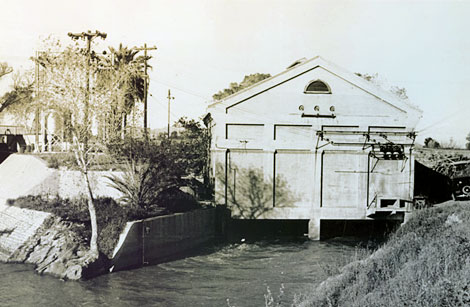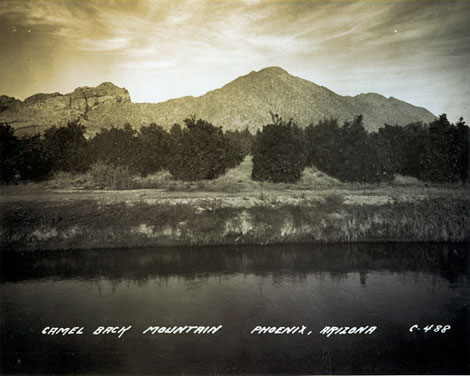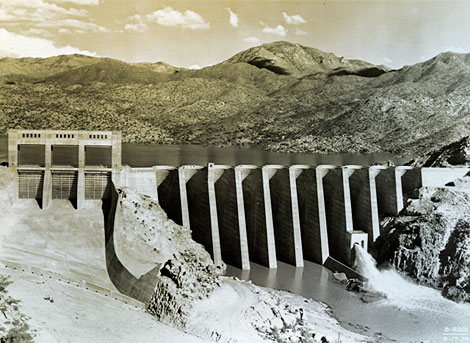

 Arizona Falls, located on the Arizona Canal, was the first of four hydropower plants built on SRP canals. These plants generated electricity to supplement that produced by Roosevelt Dam. (Courtesy of Salt River Project)
Arizona Falls, located on the Arizona Canal, was the first of four hydropower plants built on SRP canals. These plants generated electricity to supplement that produced by Roosevelt Dam. (Courtesy of Salt River Project) This citrus grove is located along the Arizona Canal from which it receives its irrigation water (Camelback Mountain is in the background). For many years, providing water for irrigation was the primary goal of the Salt River Valley Water Users Association. (Courtesy of Salt River Project)
This citrus grove is located along the Arizona Canal from which it receives its irrigation water (Camelback Mountain is in the background). For many years, providing water for irrigation was the primary goal of the Salt River Valley Water Users Association. (Courtesy of Salt River Project)The dual objectives of maximizing hydropower generation and providing efficient irrigation became a delicate balancing act that was often at cross-purposes. In the early 1930s, some Salt River Valley farmers felt that the Salt River Valley Water Users Association's (Association) management had forgotten its true purpose and lost its way. Critics protested that the pursuit of hydropower distracted the Association's leadership from the heart and soul of the project: water storage and irrigation. In times of drought, unmet demands for water releases by Valley farmers brought accusations of favoritism to power buyers over farmers. Critics argued that the Association was timing water releases for the generation and sale of power that provided much higher revenues than irrigation.
 Bartlett Dam, located on the Verde River, was completed in 1939 by the Bureau of Reclamation. It was designed to store water for Salt River Valley farmers and did not produce electricity. (Courtesy of Salt River Project)
Bartlett Dam, located on the Verde River, was completed in 1939 by the Bureau of Reclamation. It was designed to store water for Salt River Valley farmers and did not produce electricity. (Courtesy of Salt River Project)The Association offered to sell power to Valley farms to pump irrigation water rather than release reservoir storage. Farmers often objected to this new policy based on claims that they were legally entitled to river flow that they considered to be of a much higher quality than pumped water. The bickering within the Association, caused by the apparently irreconcilable differences between the business of irrigation and hydropower, eventually reached Washington D.C. In a 1937 memo, the Bureau of Reclamation Commissioner noted that in light of the dispute, the Association might consider turning over all the power facilities to the United States.

 By the 1930s, electric appliances such as cooking ranges and even dishwashers were becoming increasingly common in many urban areas such as metropolitan Phoenix. More power was needed as the demand for electric appliances, tools, radios, and other items grew. Meeting the needs of farmers for irrigation water and consumers for electricity was a delicate balancing act for the Salt River Valley Water Users Association.
By the 1930s, electric appliances such as cooking ranges and even dishwashers were becoming increasingly common in many urban areas such as metropolitan Phoenix. More power was needed as the demand for electric appliances, tools, radios, and other items grew. Meeting the needs of farmers for irrigation water and consumers for electricity was a delicate balancing act for the Salt River Valley Water Users Association.Several developments in the late 1930s reduced tensions between proponents for hydropower and those for irrigation. Bartlett Dam, a new storage facility on the Verde River, was completed by the Bureau of Reclamation. Its sole purpose was to store water for irrigation. Pump storage technology allowed the use of inexpensive, off-peak power to replenish reservoir capacity by pumping from the tailwaters below the dam back up into the reservoir at night. The development of more steam plants in the Valley and completion of transmission lines for Colorado River power in 1940 also reduced demands on power generation.
The changes that occurred in the 1920s and 1930s were not just about the growth of the Association and the Salt River Project, but the beginnings of a metamorphosis in the Salt River Valley from an agricultural/rural area with irrigation as a priority to a non-agricultural, urban region with a continuing need for energy.
